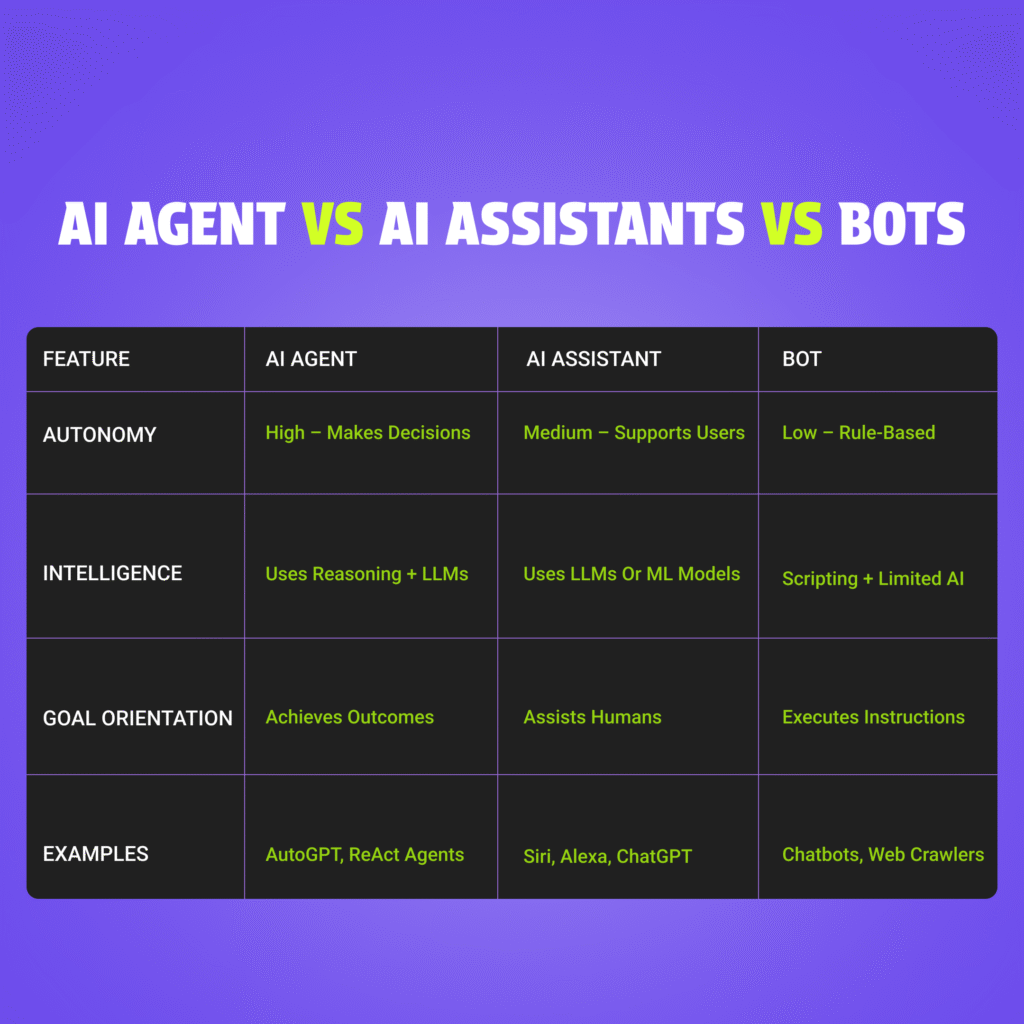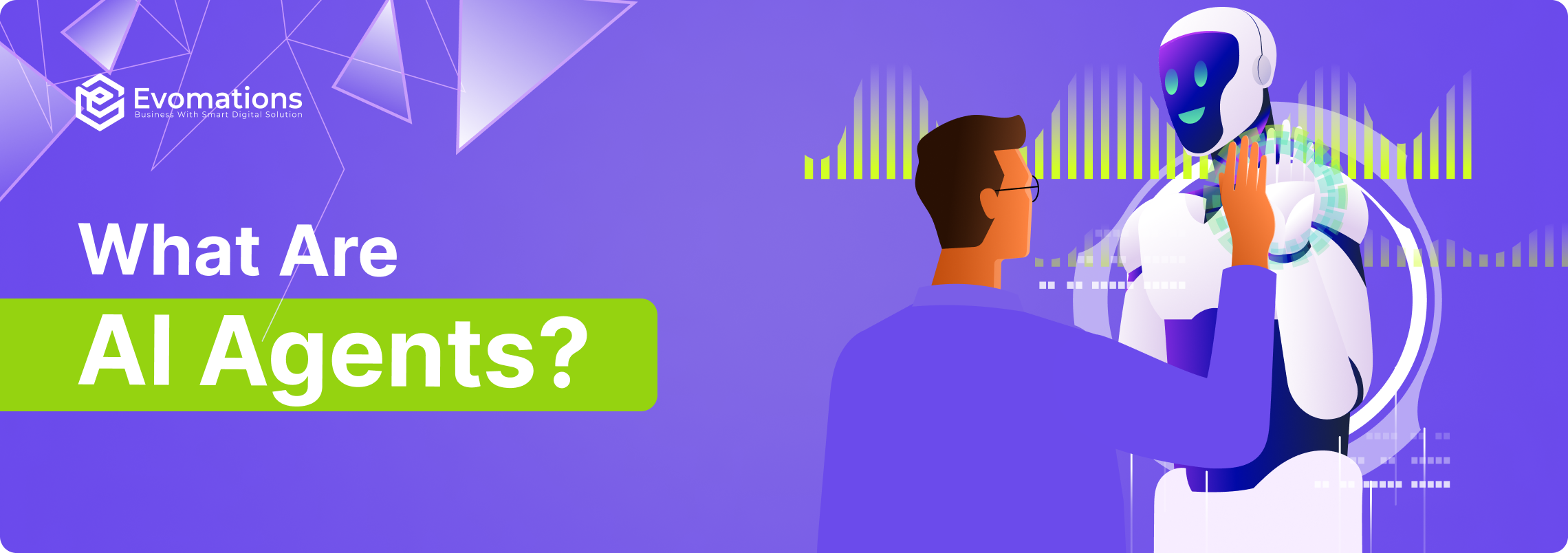- Written by: Nora James
- August 19, 2025
- Categories: AI Agents
You’ve probably noticed that technology is starting to feel a lot more capable. It’s not just answering questions or following scripts anymore, it’s actually helping with real work, from scheduling meetings to writing emails or running parts of a business. That’s where this AI Agents guide comes in.
We’re diving into a new kind of digital helper that can take action, make decisions, and learn as it goes. These aren’t just tools, they’re more like teammates you don’t have to micromanage.
If you’re curious about what they are, how they work, and how they might fit into your day-to-day, keep reading.
What is an AI Agent?
An AI agent is a software entity that perceives its environment, makes decisions, and takes
actions autonomously to achieve specific goals. Think of it as a digital decision-maker, it doesn’t just analyse data; it acts on it.
In simple terms:
An AI agent is like a virtual employee with its own “brain” that can reason, plan, and execute tasks without constant human direction.
These agents may operate independently or collaborate with humans. They’re often used for automation, optimisation, and enhancing user experience.
How Are AI Agents Related to LLMs (Large Language Models)?
AI agents often leverage Large Language Models (LLMs) like GPT, Claude, or Gemini as their core reasoning engine. These models provide the natural language understanding and generation capabilities that allow agents to interpret complex queries, generate meaningful responses, and even plan multi-step strategies.
However, while LLMs are powerful in processing language and generating text, they are not inherently agents. An LLM becomes part of an AI agent when it’s integrated into a system that includes:
- Memory modules (short-term and long-term memory)
- Planning systems
- Action execution frameworks
- Feedback loops for learning and improvement
AI agents use LLMs as their brain, but they also need a body, a set of tools and interfaces, to act in the real world.
How Might AI Agents Affect Business Growth?
AI agents have the potential to revolutionise how businesses operate by automating complex workflows, enhancing decision-making, and enabling 24/7 operation without fatigue.
Potential Impacts on Business Growth:
Increased Efficiency
AI agents can handle repetitive, high-volume tasks such as customer service, lead qualification, data entry, and report generation, freeing up human employees to focus on higher-value activities.
Scalability
Unlike human workers, AI agents can scale instantly. One agent can become ten thousand with minimal marginal cost, making them ideal for growing companies.
Improved Decision-Making
With access to real-time data and predictive analytics, AI agents can assist or even autonomously make strategic business decisions.
Enhanced Customer Experience
Agents can offer personalised interactions, support multiple languages, and provide instant responses, greatly improving user satisfaction and retention.
Cost Reduction
By reducing the need for manual labor in certain areas, AI agents can significantly lower operational costs.
Innovation Acceleration
Businesses can deploy AI agents to explore new markets, test hypotheses, and prototype products faster than ever before.
AI Agents vs. AI Assistants vs. Bots

AI agents are proactive and goal-oriented, while assistants are reactive, and bots are automated but unintelligent.
How Do AI Agents Work?
To really understand how AI agents work, it helps to think of them as digital decision-makers. They’re not just responding to inputs like a basic chatbot — they’re thinking, planning, and acting based on goals.
At a high level, AI agents operate in a loop that mimics how humans solve problems:
Perceive → Think → Act → Learn (Repeat)
Let’s break this down.
1. Perceive: Taking in Information
First, the AI agent observes what’s going on. This could be:
- A user giving a command (“Find me the cheapest flight to Tokyo.”)
- A change in data (an inventory drop, a calendar update, a website update)
- A system notification or external event
This step is all about gathering context, just like how we read a situation before acting.
2. Think: Deciding What to Do
Next, the agent thinks, not in the human sense, but in terms of processing logic, strategy, and reasoning.
This is where tools like large language models (LLMs) come in. The agent might:
- Break the task into smaller steps
- Weigh different options
- Search for needed data
- Plan a sequence of actions
For example:
If you ask an AI agent to book a flight, it won’t just go buy a random ticket. It’ll consider your preferences, check dates, compare prices, maybe even ask clarifying questions.
This is the “brain” of the operation, often powered by advanced AI models like GPT or Claude.
3. Act: Taking Real-World Action
Once it knows what to do, the AI agent moves to the action phase.
Depending on its capabilities, it might:
- Make an API call to book something
- Send an email or message
- Input data into a CRM or spreadsheet
- Open a web browser and scrape information
- Schedule a meeting on your calendar
The key here is autonomy. The agent doesn’t just suggest what you could do, it actually does it (within limits you set).
4. Learn: Reflecting and Improving
After acting, a good AI agent doesn’t just move on blindly. It reflects on what happened.
Did the task succeed?
Was the result useful?
Should the next attempt be different?
Some agents use feedback loops to improve over time. They might store successful workflows, update their internal “memory,” or adjust how they handle similar requests in the future.
The best AI agents don’t just repeat instructions, they learn from outcomes and get smarter with each run.
Bonus: Tools AI Agents Use to Work
To carry out all this, agents often use:
- LLMs (for understanding and reasoning)
- Tools or APIs (to interact with software or services)
- Planners (to map out multi-step goals)
- Memory (to store past actions or preferences)
- Execution environments (like Python, browser-based tools, or cloud platforms)
Types of AI Agents
Not all AI agents are created equal. Just like people have different roles, like planners, responders, or problem-solvers, AI agents come in different types, each built for specific purposes.
Understanding these types helps you figure out what kind of agent you need (or are already using), whether it’s one that reacts instantly, plans ahead, or learns from experience.
Let’s break down the main types
1. Reactive Agents – The Fast Responders
These are the simplest kind of AI agents. They don’t think deeply or plan ahead, they just respond to what’s happening right now based on a set of rules or patterns.
They don’t have memory.
They don’t “learn” from the past.
They react to inputs in real time.
Think of them like a light switch: If motion is detected, turn the light on. That’s it.
Example:
An AI security camera that detects motion and sends an alert, it’s not analysing your history or trying to predict future events. It’s purely reactive.
Use case: Great for time-sensitive tasks that need instant responses (e.g., fraud detection, alerts, monitoring systems).
2. Deliberative Agents – The Planners and Thinkers
These agents are much more advanced. They don’t just react, they reason, make plans, and consider consequences before acting.
They have an internal model of the world or environment.
They can simulate outcomes.
They choose the best course of action based on goals.
Think of them like a GPS system: It doesn’t just tell you where you are, it calculates the best route to your destination and reroutes if things change.
Example:
A travel planning agent that compares flight options, hotel rates, and weather forecasts to give you the best itinerary.
Use case: Ideal for multi-step problem solving where planning is essential (e.g., business strategy agents, robotic navigation, supply chain optimisation).
3. Learning Agents – The Ones That Get Smarter
These agents can learn from experience and adapt over time. They often start simple, but the more they interact with users or data, the better they get.
They have memory and feedback loops.
They improve performance over time.
They adjust behaviour based on outcomes.
Think of them like a personal assistant who gradually understands your preferences, how you like your coffee, what kind of meetings you avoid, or the times you’re usually most productive.
Example:
An AI email agent that learns which kinds of emails you reply to, which ones you ignore, and starts filtering and drafting responses accordingly.
Use case: Perfect for personalised workflows, dynamic environments, and anything that benefits from long-term optimisation (e.g., marketing agents, customer service agents, user behavior modeling).
4. Multi-Agent Systems – The Team Players
Sometimes, a single agent isn’t enough. In more complex environments, you’ll find multiple AI agents working together, each handling part of the problem.
They collaborate, coordinate, or even compete.
Each agent may have a different speciality.
The group behaves like a system of intelligent collaborators.
Think of it like a project team: one person handles research, another designs the solution, and someone else executes the task, but they all work together toward the same goal.
Example:
An autonomous warehouse system where one agent manages inventory, another coordinates robot workers, and another tracks orders and deliveries, all in sync.
Use case: Best for large-scale operations like simulations, logistics, smart cities, or decentralized systems.
Use Cases of AI Agents
AI agents aren’t just futuristic tools limited to tech companies. They’re already working behind the scenes across industries and in everyday workflows. Whether it’s customer support, operations, or marketing, AI agents are quietly transforming how work gets done, making processes smarter, faster, and more efficient.
Here are some of the most common and impactful use cases.
1. Customer Support Agents
AI agents are redefining customer service by handling repetitive questions, resolving common issues, and escalating more complex ones when needed. These agents can operate 24/7, offering immediate assistance without requiring human intervention.
Example: A retail chatbot that tracks orders, processes returns, and answers frequently asked questions.
Why it matters: Businesses can reduce response times and support costs, while customers get faster, more consistent service.
2. Personal Productivity Agents
These agents act like highly capable digital assistants. They manage calendars, schedule meetings, organise emails, and help streamline daily tasks, all with minimal user input.
Example: A scheduling agent that finds mutually available time slots across calendars, sends invites, and automatically reschedules if something changes.
Why it matters: You gain back valuable time by offloading repetitive administrative work to an intelligent system.
3. Sales and Marketing Agents
In sales and marketing, AI agents personalise outreach, qualify leads, analyse buyer behavior, and even write emails based on a customer’s profile or interaction history.
Example: A lead generation agent that crafts customised outreach emails and follows up at optimal times based on engagement data.
Why it matters: Teams can scale their outreach, improve lead quality, and focus on high-value conversations.
4. Operations and Workflow Agents
These agents help automate and streamline internal processes such as procurement, logistics, and project management. They ensure tasks move forward efficiently without constant oversight.
Example: An inventory management agent that monitors stock levels and automatically reorders supplies when thresholds are met.
Why it matters: Reduces bottlenecks, minimises human error, and improves operational efficiency.
5. Data Analysis Agents
AI agents can analyse large sets of data and surface key insights. They are useful for teams that need actionable information but don’t have time or expertise in data science.
Example: A business intelligence agent that reviews campaign data across platforms and delivers a daily summary of trends and performance.
Why it matters: Faster insights lead to better decisions and more responsive strategies.
6. Developer and Engineering Agents
In software development, AI agents assist with writing code, debugging, documenting, and even reviewing pull requests. They act as tireless collaborators for engineers.
Example: A coding assistant that understands your codebase and suggests solutions for bugs or incomplete features.
Why it matters: Developers can focus more on creative problem-solving and less on repetitive coding tasks.
7. Education and Learning Agents
AI agents in education personalise the learning experience, provide real-time feedback, and adjust content based on a learner’s pace and progress.
Example: A tutoring agent that adapts math lessons based on a student’s past performance and offers guided practice sessions.
Why it matters: Learners get a more customised, supportive experience, improving engagement and comprehension.
8. Security Agents
In cybersecurity and IT, AI agents monitor systems for threats, identify anomalies, and respond to incidents faster than any human team could.
Example: A threat detection agent that flags unusual login behavior and automatically locks down access to prevent breaches.
Why it matters: Organisations can strengthen their security posture and reduce the time between detection and action.
9. Creative and Content Agents
Creative professionals use AI agents to assist with brainstorming, drafting, and even polishing content. These agents support writing, design, and media creation processes.
Example: A content creation agent that helps generate blog outlines, headlines, or SEO-friendly copy.
Why it matters: Content teams can produce more high-quality work with less time spent on repetitive tasks.
Wrapping up
The tools we use to get things done are changing fast. What used to take hours, or a whole team, can now happen in minutes with the right setup.
These smart digital helpers are already starting to take on small but meaningful roles in our lives and work. And while they’re not perfect, they’re only going to get better from here.
The big question isn’t whether they’re coming, it’s how we’ll choose to use them.
Ready to unlock the power of AI Agents for your business?
Learn more about AI Agents and how to implement them today!


